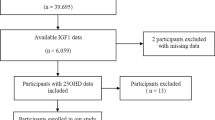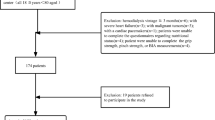Abstract
A decreased hemoglobin concentration is a common clinical condition in elderly subjects, and in at least 20% of the cases it is not possible to directly attribute the anemia to specific factors. The aim of the present study was to evaluate the relationship of different levels of insulin-like growth factor-binding protein 3 (IGFBP-3) with the blood concentration of hemoglobin in persons aged 80 years and older. Data are from a baseline evaluation of the Aging and Longevity in the Sirente Geographic Area (ilSIRENTE) study (n = 253). Analysis of covariance was used to examine the effect of different IGFBP-3 levels on hemoglobin concentration. After adjustment for potential confounding variables, which included age, sex, number of diseases, renal failure, cancer, gastric ulcer, albumin, and iron concentrations, individuals in the group with higher IGFBP-3 concentrations showed a significantly higher mean hemoglobin concentration than participants in the group with lower IGFBP-3 concentrations (13.4± 1.4 g/dL versus 12.9± 1.9 g/dL, respectively; P = .03). In conclusion, the present study has shown that a higher IGFBP-3 level is associated with a higher hemoglobin concentration among older people living in the community. This finding suggests that the growth hormone/IGF axis may play an important role in hematopoiesis, and it may be implicated in the age-related decline in hemoglobin concentration.
Similar content being viewed by others
References
World Health Organization. Nutritional Anaemias — Report of a WHO Scientific Group. (Technical Report Series no. 405). Geneva, Switzerland: World Health Organization, 1968.
Guralnik JM, Eisenstaedt RS, Ferrucci L, Klein HG,Woodman RC. Prevalence of anemia in persons 65 years and older in the United States: evidence for a high rate of unexplained anemia. Blood. 2004;104:2263–2268.
Salive ME, Cornoni-Huntley J, Guralnik JM, et al. Anemia and hemoglobin levels in older persons: relationship with age, gender, and health status. J Am Geriatr Soc. 1992;40:489–496.
Joosten E, Pelemans W, Hiele M, Noyen J, Verhaeghe R, Boogaerts MA. Prevalence and causes of anaemia in a geriatric hospitalized population. Gerontology. 1992;38:111–117.
Ania BJ, Suman VJ, Fairbanks VF, Rademacher DM, Melton LJ 3rd. Incidence of anemia in older people: an epidemiologic study in a well defined population. J Am Geriatr Soc. 1997;45:825–831.
Izaks GJ, Westendorp RG, Knook DL. The definition of anemia in older persons. JAMA. 1999;281:1714–1717.
Miyagawa S, Kobayashi M, Konishi N, Sato T, Ueda K. Insulin and insulin-like growth factor I support the proliferation of erythroid progenitor cells in bone marrow through the sharing of receptors. Br J Haematol. 2000;109:555–562.
Sawada K, Krantz SB, Dessypris EN, Koury ST, Sawyer ST. Human colony-forming units-erythroid do not require accessory cells, but do require direct interaction with insulin-like growth factor I and/or insulin for erythroid development. J Clin Invest. 1989;83:1701–17099.
Boyer SH, Bishop TR, Rogers OC, Noyes AN, Frelin LP, Hobbs S. Roles of erythropoietin, insulin-like growth factor 1, and unidentified serum factors in promoting maturation of purified murine erythroid colony-forming units. Blood. 1992;80:2503–2512.
Akahane K,Tojo A, Urabe A, Takaku F Pure erythropoietic colony and burst formations in serum-free culture and their enhancement by insulin-like growth factor I. Exp Hematol. 1987;15:797–802.
Merchav S, Silvian-Drachsler I, Tatarsky I, Lake M, Skottner A. Comparative studies of the erythroid-potentiating effects of biosynthetic human insulin-like growth factors-I and -II. J Clin Endocrinol Metab. 1992;74:447–452.
Vihervuori E, Virtanen M, Koistinen H, Koistinen R, Seppala M, Siimes MA. Hemoglobin level is linked to growth hormone-dependent proteins in short children. Blood. 1996;87:2075–2081.
Kurtz A, Zapf J, Eckardt KU, Clemons G, Froesch ER, Bauer C. Insulin-like growth factor I stimulates erythropoiesis in hypophy-sectomized rats. Proc Natl Acad Sci U S A. 1988;85:7825–7829.
Anttila R, Koistinen R, Seppala M, Koistinen H, Siimes MA. Insulin-like growth factor I and insulin-like growth factor binding protein 3 as determinants of blood hemoglobin concentration in healthy subjects. Pediatr Res. 1994;36:745–748.
Nilsson-Ehle H, Bengtsson BA, Lindstedt G, Mellstrom D. Insulin- like growth factor-1 is a predictor of blood haemoglobin concentration in 70-yr-old subjects. Eur J Haematol. 2005;74:111–116.
Landi F, Russo A, Cesari M, et al. The ilSIRENTE study: a prospective cohort study on persons aged 80 years and older living in a mountain community of Central Italy. Aging Clin Exp Res. 2005; 17:486–493.
Landi F, Sgadari A, Cipriani L, et al. A simple program to train case managers in community elderly care. Aging Clin Exp Res. 1996; 8:211–218.
Morris JN, Fries BE, Meher DR, et al. MDS Cognitive Performance Scale. J Gerontol. 1994;49:M174-M182.
Morris JN, Fries BE, Bernabei R, Ikegami N, Gilgen R, Steel K. RAI -Home Care Assessment Manual. Washington, DC: Inter RAI Corporation; 1996.
Morris JN, Fries BE, Steel K, et al. Comprehensive clinical assessment in community setting: applicability of the MDS-HC. J Am Geriatr Soc. 1997;45:1017–1024.
Landi F,Tua E, Onder G, et al. Minimum data set for home care: a valid instrument to assess frail older people living in the community. Med Care. 2000;38:1184–1190.
Ferrucci L, Bandinelli S, Benvenuti E, et al. Subsystems contributing to the decline in ability to walk: bridging the gap between epidemiology and geriatric practice in the InCHIANTI study. J Am Geriatr Soc. 2000;48:1618–1625.
Singer CF, Mogg M, Koestler W, et al. Insulin-like growth factor (IGF)-I and IGF-II serum concentrations in patients with benign and malignant breast lesions: free IGF-II is correlated with breast cancer size. Clin Cancer Res. 2004;10:4003–4009.
Huysman MW, Hokken-Koelega AC, Hop WC, Sauer PJ. Effect of dexamethasone treatment on serum GH, IGF-1, and the binding proteins IGFBP-1 and -3 in ventilated very preterm infants. Pediatr Res. 2003;54:37–43.
Zumkeller W. The insulin-like growth factor system in hemato-poietic cells. Leuk Lymphoma. 2002;43:487–491.
Sohmiya M, Kato Y. Human growth hormone and insulin-like growth factor-I inhibit erythropoietin secretion from the kidneys of adult rats. J Endocrinol. 2005;184:199–207.
Sohmiya M, Kanazawa I, Kato Y. Effect of recombinant human GH on circulating granulocyte colony-stimulating factor and neutrophils in patients with adult GH deficiency. Eur J Endocrinol. 2005;152:211–215.
Choi JW, Kim SK. Association of serum insulin-like growth factor- I and erythropoiesis in relation to body iron status. Ann Clin Lab Sci. 2004;34:324–328.
French RA, Broussard SR, Meier WA. Age-associated loss of bone marrow hematopoietic cells is reversed by GH and accompanies thymic reconstitution. Endocrinology. 2002;143:690–699.
Taub DD, Tsarfaty G, Lloyd AR, Durum SK, Longo DL, Murphy WJ. Growth hormone promotes human T cell adhesion and migration to both human and murine matrix proteins in vitro and directly promotes xenogeneic engraftment. J Clin Invest. 1994;94:293–3000.
Hanley MB, Napolitano LA, McCune JM. Growth hormone-induced stimulation of multilineage human hematopoiesis. Stem Cells. 2005;23:1170–1179.
Rusten LS, Jacobsen SE, Kaalhus O, Veiby OP, Funderud S, Smeland EB. Functional differences between CD38? and DR? subfractions of CD34+ bone marrow cells. Blood. 1994;84:1473–1481.
Huang S, Terstappen LW. Lymphoid and myeloid differentiation of single human CD34+, HLA-DR+, CD38? hematopoietic stem cells. Blood. 1994;83:1515–1526.
Abboud SL, Bethel CR, Aron DC. Secretion of insulin-like growth factor I and insulin-like growth factor-binding proteins by murine bone marrow stromal cells. J Clin Invest. 1991;88:470–475.
Makitie O, Juvonen E, Dunkel L, Kaitila I, Siimes MA. Anemia in children with cartilage-hair hypoplasia is related to body growth and to the insulin-like growth factor system. J Clin Endocrinol Metab. 2000;85:563–568.
Urena P, Bonnardeaux A, Eckardt KU, Kurtz A, Drueke TB. Insulin-like growth factor I: a modulator of erythropoiesis in uraemic patients? Nephrol Dial Transplant. 1992;7:40–44.
Christ ER, Cummings MH, Westwood NB, et al. The importance of growth hormone in the regulation of erythropoiesis, red cell mass, and plasma volume in adults with growth hormone deficiency. J Clin Endocrinol Metab. 1997;82:2985–2990.
Ten Have SM, van der Lely AJ, Lamberts SW. Increase in haemoglobin concentrations in growth hormone deficient adults during human recombinant growth hormone replacement therapy. Clin Endocrinol (Oxf). 1997;47:565–570.
Moller N, Moller J, Jorgensen JO, et al. Impact of 2 weeks high dose growth hormone treatment on basal and insulin stimulated substrate metabolism in humans. Clin Endocrinol (Oxf). 1993;39:577–5811.
Lamberts SW, Valk NK, Binnerts A. The use of growth hormone in adults: a changing scene. Clin Endocrinol (Oxf). 1992;37:111–115.
Author information
Authors and Affiliations
Corresponding author
About this article
Cite this article
Landi, F., Russo, A., Capoluongo, E. et al. Insulin-like Growth Factor-Binding Protein 3 and Hemoglobin Concentration in Older Persons Living in the Community. Int J Hematol 85, 294–299 (2007). https://doi.org/10.1532/IJH97.E0629
Received:
Revised:
Accepted:
Published:
Issue Date:
DOI: https://doi.org/10.1532/IJH97.E0629




